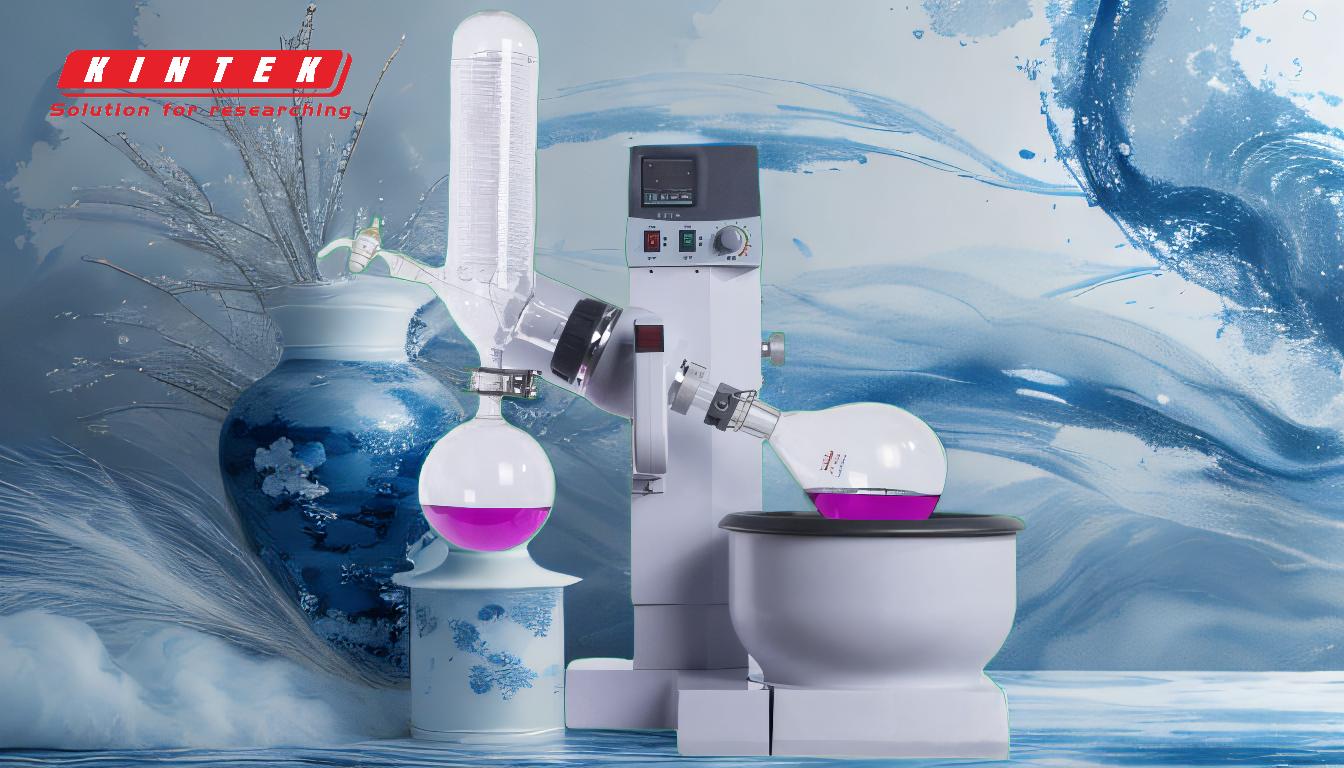The rotary evaporation (rotovap) technique is a widely used method in laboratories for the efficient and gentle removal of solvents from samples. It operates under reduced pressure to lower the boiling point of the solvent, allowing it to evaporate at lower temperatures. This process involves rotating the sample flask in a heated water bath, creating a thin film of the solution that enhances evaporation. The solvent vapors are then condensed and collected in a separate flask. The technique is particularly useful for heat-sensitive compounds, as it minimizes thermal degradation and oxidation. Key components of a rotovap include a vacuum pump, motorized rotation mechanism, heated water bath, condenser, and collection flask. The process is precise, efficient, and essential in fields like chemistry, pharmaceuticals, and food science.
Key Points Explained:

-
Principle of Operation:
- The rotovap technique relies on the principle that the boiling point of a solvent decreases under reduced pressure. By operating under a vacuum, the solvent can be evaporated at a much lower temperature than its standard boiling point, which is crucial for heat-sensitive compounds.
- The rotation of the evaporation flask creates a thin film of the solution on the glass surface, increasing the surface area and speeding up the evaporation process. This ensures even heating and mixing, leading to stable and efficient evaporation.
-
Key Components:
- Vacuum Pump: Creates the reduced pressure necessary to lower the solvent's boiling point.
- Motor Unit: Rotates the evaporation flask, enhancing the evaporation process by spreading the solution into a thin film.
- Heated Water Bath: Provides controlled heating to the sample, ensuring that the solvent evaporates at the desired rate.
- Condenser: Cools the evaporated solvent vapors, causing them to condense back into a liquid, which is then collected in a separate flask.
- Vapor Duct: Acts as a vacuum-tight conduit for the vapors to travel from the evaporation flask to the condenser.
- Collection Flask: Collects the condensed solvent, allowing for easy recovery and reuse.
-
Process Steps:
- Sample Preparation: The solution is added to the evaporation flask, typically filled to no more than 50% of its capacity to prevent bumping (sudden boiling).
- Vacuum Application: The vacuum pump is activated to reduce the pressure within the system, lowering the solvent's boiling point.
- Heating and Rotation: The flask is immersed in a heated water bath and rotated at a controlled speed (usually 150-200 rpm). The rotation creates a thin film of the solution, enhancing evaporation.
- Condensation: The evaporated solvent vapors travel through the vapor duct to the condenser, where they are cooled and condensed back into a liquid.
- Collection: The condensed solvent is collected in a separate flask, while the concentrated sample remains in the evaporation flask.
-
Advantages:
- Gentle Evaporation: The reduced pressure allows for evaporation at lower temperatures, minimizing the risk of thermal degradation of heat-sensitive compounds.
- Efficiency: The rotation of the flask increases the surface area, speeding up the evaporation process and ensuring even heating.
- Precision: The controlled environment (temperature, pressure, and rotation speed) allows for precise control over the evaporation process.
- Solvent Recovery: The condensed solvent can be easily collected and reused, reducing waste and cost.
-
Applications:
- Chemistry: Used for the concentration of reaction mixtures, purification of compounds, and removal of solvents.
- Pharmaceuticals: Essential for the extraction and purification of active pharmaceutical ingredients (APIs) and other sensitive compounds.
- Food Science: Utilized for the concentration of flavors, essences, and other natural extracts without compromising their quality.
- Environmental Analysis: Applied in the extraction and concentration of environmental samples for analysis.
-
Considerations for Purchasers:
- Capacity: Choose a rotovap with an appropriate flask size for your sample volumes.
- Vacuum Performance: Ensure the vacuum pump can achieve the necessary pressure reduction for your specific solvents.
- Temperature Control: Look for precise temperature control in the water bath to handle heat-sensitive materials.
- Condenser Efficiency: A high-efficiency condenser is crucial for effective solvent recovery.
- Safety Features: Consider models with bump guards and vacuum release valves to prevent accidents and ensure safe operation.
In summary, the rotary evaporation technique is a versatile and essential tool in many scientific fields, offering a gentle and efficient method for solvent removal. Understanding its components, process, and applications can help purchasers select the right equipment for their needs.
Summary Table:
| Aspect | Details |
|---|---|
| Principle | Lowers solvent boiling point under reduced pressure for gentle evaporation. |
| Key Components | Vacuum pump, motor unit, heated water bath, condenser, collection flask. |
| Advantages | Gentle evaporation, efficiency, precision, solvent recovery. |
| Applications | Chemistry, pharmaceuticals, food science, environmental analysis. |
| Considerations | Capacity, vacuum performance, temperature control, safety features. |
Discover how rotary evaporation can optimize your lab processes—contact us today for expert advice!












